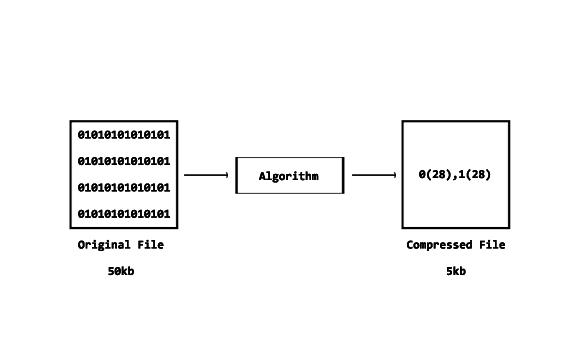What is Compression?
The process of reducing data by applying a compression technique is called compression, and the resulting data is called compressed data. The reverse process of reproducing the original data from compressed data is called decommission, while the resulting data is called decompressed data.
Compression Techniques
When you have a file containing text, there can be repetitive single words, combination of words and phrases that use up storage space unproductively. Or there can be media such as high-tech graphical images in it whose data information occupies too much space. To reduce this inefficiency electronically, you can compress the document.

Compression is done by using compression algorithms (formulae) that rearrange and reorganize data information so that it can be stored more economically. By encoding information, data can be stored using fewer bits. This process is done by using a compression/decompression program that alters the structure of the data temporarily for transporting, reformatting, archiving, saving, etc.
Compression is the reduction in size of data in order to save space or transmission time. For data transmission, compression can be preformed on just the data content or on the entire transmission unit (including header data) depending on a number of factor.
Lossless Compression:
Lossless compression can reduce files without loss of information in the process. The original file can be recreated exactly when uncompressed. This is important for the data uncompressed. This is important for the data and program files. This type of compression method provides an average 2:1 (Range 1.5:1 to 3:1) compression ratio, when a 10KB file is compressed, you get a file of around 5KB of size. To achieve this, algorithms create reference points (substitution characters) for things such as textual patterns, store them in a catalogue send them along with the "re-generated" by using those documented reference points to re-substitute the original information.
Lossy Compression:
Lossy compression (some information is permanently lost), on the other hand, reduces the file size be eliminating bits of information. It permanently deletes any unnecessary data. This compression is usually used with images, audio and graphics. For instance, in an image containing a green landscape with a blue sky, all the different and slight shades of blue and green are eliminated with compression. The essential nature of the data is not lost - the essential colors are still there. One popular example of lossy compression is JPEG compression (Joint Photographic Experts Group), which is suitable for gray-scale or color images.
Note: It's important to choose the compression method based on the type of data being compressed and the specific requirements of the application.
Category: Software
on: 25 Sep 2019
on: 29 Dec 2022
Featured posts
You may like these posts.
GPU - World First GPU Details & Where Company's use GPUs:
GPU (Graphics Processing Unit) is an electronic circuit used to speed up the creation of both 2D and 3D images. A GPU can be present on a video card.

Basic Concept of Memory Management:
Memory Management is the functionality of an operating system that handles or manages the primary memory and disk during execution.

Cache Memory - Types & Levels of Cache Memory:
A CPU cache is a cache memory used by the CPU of a computer to reduce the average time to access main memory. The Cache is a smaller & faster memory.
What's Next?
We've now entered the finance section on this platform, where you can enhance your financial literacy.
